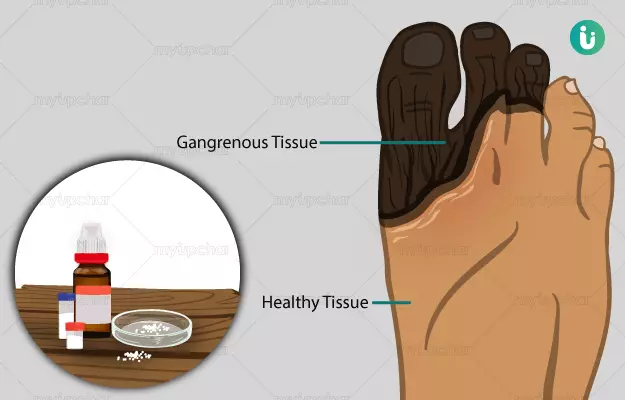Gangrene is a serious medical condition in which loss of blood circulation to a tissue causes it to die. It can affect any part of the body but is most commonly seen in the toes, feet, fingers and hands. Gangrene usually occurs as a result of an injury, infection or chronic conditions that impede blood circulation.
There are two types of gangrene: dry gangrene and wet gangrene.
Dry gangrene occurs when the blood supply is cut off as a result of a pre-existing health condition, such as diabetes. The high blood sugar levels in diabetes damage the blood vessels, leading to compromised circulation, reduced oxygen supply and tissue death. The affected region appears dry, shrivelled and black.
Wet gangrene is caused by an infection that can occur after an injury, burn or even a frostbite.
People who have a weak immune system, such as diabetic patients, are at a higher risk of developing wet gangrene as they are more prone to bacterial infections. Regions affected with wet gangrene appear swollen, moist and tend to have oozing pus. Gangrene may develop at the site of foot ulcers which is a common complication of type 1 and type 2 diabetes.
Symptoms of gangrene include:
- Swelling and redness of the affected part
- Loss of sensation or severe pain in the affected area
- Presence of blisters or sores that may bleed or release a foul-smelling discharge
- Skin becoming cold or pale
- Heaviness in the limbs
- Crackling sound on pressing the area due to build-up of gas under the skin
- High fever of 38°C or more
- Loss of appetite
- Rapid heartbeat
- Fast breathing
- Dizziness
Without immediate treatment, the tissue will begin to die. In such cases, the area changes colour from red to blue or black, shrivels and falls off. If the bacteria enter the bloodstream, a person may go into septic shock, which is a life-threatening condition. Signs of septic shock are:
- Weak and rapid pulse
- Dizziness
- Mental confusion or disorientation
- Difficulty in breathing
- Vomiting
- Diarrhoea
- Pale, cold and clammy skin
It is important to know the signs of gangrene so that it can be treated in the early stages, as severe cases of gangrene tend to result in amputation as they are hard to salvage. Other conventional methods of treating gangrene include surgery to reconstruct the damaged vessels, antibiotics for treating the infection, oxygen therapy to stimulate healthy healing and even maggot treatment as they eat dead tissue and release secretions that kill the bacteria.
Homeopathy prescribes numerous remedies to treat gangrene and its related symptoms. These medicines help in restoring blood circulation and healing of the affected part. Some of the medicines are anthracinum, arsenic album, asafoetida, cantharis, carbo veg, causticum, crotalus, hamamelis, kreosote, lachesis, plumbum met, secale cor and stramonium.
- How effective are homeopathic medicines and treatments for Gangrene
- Homeopathic medicines for Gangrene
- Dietary and lifestyle changes for Gangrene as per homeopathy
- Side effects and risks of homeopathic medicine and treatment for Gangrene
- Takeaway
How effective are homeopathic medicines and treatments for Gangrene
Homeopathic remedies are holistic medicines that contain diluted natural substances and are free of adverse effects. They can be safely used in individuals of all age groups. The medicines are prescribed after a detailed evaluation of the individual’s traits, and thus it is important to consult a qualified homeopathic physician before initiating therapy.
There are many remedies in homeopathy which can be used in the management of gangrene. These medicines stimulate the body’s immune mechanisms and help to restore blood circulation to the affected area. Medicines are carefully selected based on the totality of the patient’s symptoms and not just the diseased part. These medicines not only focus on the pathology of the gangrene but also on the person’s immune system, thereby promoting a natural healing process. It also saves the patient from surgery and the psychological consequences of amputation.
Homeopathic medicines for Gangrene
Anthracinum
Common Name: Anthrax poison
Symptoms: This remedy acts on the tissue level in the treatment of conditions such as gangrene, abscesses, boils and ulcers. Other symptoms treated by this remedy include -
- Gangrene with septic states
- Swelling of glands and tissues
- Thick, black, tar-like bleeding from any orifice
- Boils appearing one after the other
- Foul-smelling discharge
- Carbuncles
- Malignant ulcers
Arsenicum Album
Common Name: Arsenious acid
Symptoms: It acts on every organ and tissue of the body and relieves gangrenous affections associated with burning pains, irritable weakness and restlessness. Some of the other symptoms treated by this remedy are -
- Swellings with burning sensation
- Stubborn eruptions
- Ulcers with foul secretions
- Urticaria with burning and restlessness
- Weakness, heaviness and uneasiness in the limbs
- Gangrene and inflammation of the affected parts
The symptoms worsen in wet weather, after midnight, at the seashore and from cold drinks and food. The symptoms get better from heat and warm drinks.
Asafoetida
Common Name: Gum of the stinkasand
Symptoms: This remedy is well suited for gangrene associated with extreme sensitiveness and throbbing of the affected parts. Other symptoms include -
- Ulcers that are painful on the edges
- Suppressed skin symptoms producing nervous disorders
- Pain, ulcers and caries in the bones
- Flatulence and reflux of liquids
- Excessive gas in the abdomen
The symptoms become worse at night, on the left side, at rest and with warm applications. They get better in open air, from motion and pressure.
Cantharis Vesicatoria
Common Name: Spanish fly
Symptoms: This is an excellent remedy for the treatment of gangrene and inflammatory conditions. Other symptoms treated by this remedy are -
- Dermatitis (inflammation of the skin)
- Vesicular eruptions (fluid-filled)
- Redness and swelling (erysipelas)
- Burning in soles of feet
- Intolerable burning while passing urine
- Blood in stools
The symptoms are worsened by touch, approach, urination and drinking cold water or coffee. They get better by rubbing.
Carbo Vegetabilis
Common Name: Vegetable charcoal
Symptoms: This remedy is useful in cases where the blood circulation is poor, leading to stagnation, blueness and coldness of the affected parts. In these conditions, the bacteria can grow and multiply, causing gangrene. Other symptoms include -
- Skin that is blue and cold
- Gangrene in old people
- Ulcers with burning pain
- Foul-smelling discharge
- Varicose ulcers
- Carbuncles
- Red, swollen toes
The symptoms are worse in the evening, at night, in open air, in the cold and in warm damp weather. They get better from fanning and cold.
Causticum
Common Name: Hahnemann's tinctura acris sine kali
Symptoms: This remedy is useful in cases of gangrene and tissue affections. Other symptoms treated by this remedy are -
- Pain of burns
- Soreness behind ears and between thighs
- Old burns that do not heal
- Left-sided sciatic pain
- Contracted tendons
- Restless legs at night
- Hoarseness of voice
- Pimples and warts
The complaints are worse in clear fine weather, dry and cold winds and in cold air. They get better in damp, wet weather and heat of the bed.
Crotalus Horridus
Common Name: Rattlesnake
Symptoms: This is an excellent remedy for affections of the blood and skin (gangrene), septic states and bleeding disorders. Other symptoms treated with this remedy include -
- Dark, thin blood which does not clot
- Skin that looks multicoloured
- Small bleeding spots under the skin
- Bleeding from every part of the body
- Pus-filled eruptions
- Eruptions surrounded by bluish skin
- Increased sensitivity of right side of body
The symptoms are worsened on the right side, in open air, evening, morning, spring season, warm weather and damp, wet weather.
Hamamelis Virginiana
Common Name: Witch-hazel
Symptoms: This remedy is best suited for complaints of the venous system, gangrene, piles and blood disorders. Other symptoms that can be treated include -
- Varicose veins and varicose ulcers
- Bluish black appearance of the skin
- Inflammation of the veins
- Coldness in back and hips extending to legs
- Deep vein thrombosis
- Bleeding piles with soreness
The symptoms are worse in warm and moist air.
Kreosote
Common Name: Beechwood kreosote
Symptoms: This remedy is useful for treating severe burning and acrid discharges. It is helpful in treating cases of gangrene, bleeding and cancerous affections. Other symptoms treated by this remedy include -
- Gangrene in old people
- Small wounds that bleed a lot
- Blue-purple skin on the fingers and hands
- Burning in soles
- Painful and sore shoulder bone
- Pain in hip and knee joints
- Offensive urine
- Caries of teeth as soon as they erupt
The symptoms are worse in open air, with rest, on lying down and after periods. They get better with warmth, motion and a warm diet.
Lachesis Mutus
Common Name: Bushmaster/surucucu snake
Symptoms: This remedy helps in treating cases where the blood gets decomposed, resulting in an increased tendency to haemorrhage (heavy bleeding). It is useful in gangrene with a bluish purple appearance of the skin. Other symptoms treated with this remedy are -
- Ulcers with bluish black edges
- Blue-black swellings
- Septic conditions
- Cellulitis
- Varicose ulcers
- Hot sweat
- Pain in shinbone
The symptoms are worsened after sleep, during sleep, on the left side, during spring season, with warm baths, pressure, constriction and hot drinks. They are relieved by appearance of discharges and warm applications.
Plumbum Metallicum
Common Name: Lead
Symptoms: This remedy mainly acts on the blood, digestive and nervous systems. Other symptoms treated by this remedy are -
- Weakness in walking and movement
- Paralysis and convulsions
- Paralysis of single muscles
- Swelling of feet with dilated veins
- Yellow and dry skin with dark-brown spots
- Rapid atrophy of muscles
- Blue lines on the margins of the gums
- Hard, lumpy stools which are black in colour
The symptoms are worse at night and by motion. They are relieved by hard pressure and physical exertion.
Secale Cornutum
Common Name: Ergot, claviceps purpurea
Symptoms: This is an excellent remedy for gangrene. Other symptoms treated by this remedy include -
- Haemorrhage with continuous oozing of blood
- Thin, black, watery blood with a foul smell
- Shrivelled, numb skin with a bluish tinge
- Dry gangrene which develops slowly
- Skin that feels cold to touch
- Violent cramps
- Icy coldness of limbs
- Cold hands and feet
- Fever with cold skin and cold, clammy sweat
The symptoms are worsened by warmth and covering, and better by cold, uncovering, rubbing and stretching the limbs.
Stramonium
Common Name: Thorn apple, datura
Symptoms: This remedy acts on the brain and skin. It is useful in the treatment of gangrene. Other symptoms include -
- Violent pains in left hip
- Convulsions of upper extremities and isolated groups of muscles
- Severe fever which is not relieved by sweating
- Suppression of urine
- No pain or movements in muscles
The symptoms are worse after sleep and in a dark room, and better with warmth.
Dietary and lifestyle changes for Gangrene as per homeopathy
Homeopathic remedies are useful in the management of gangrene. The homeopathic physician advises lifestyle and diet modifications along with the medicines for best results. The doctor also recommends avoiding foods that may interfere with the medicinal properties of the homeopathic remedies.
Do’s:
- Eat nutritious and healthy foods that are compatible with the treatment.
- Stay in a clean and hygienic environment.
- Include physical exercise in your daily routine.
- Maintain personal hygiene.[19]
Don’ts:
- Do not consume foods and drinks which possess medicinal properties.
- Do not drink beverages containing caffeine and drinks with strong odours.
- Do not use perfumes with a strong odour.
- Avoid extreme emotions like anger and grief that may lead to overexertion of mind.
- Avoid staying in wet and unclean rooms.
- Avoid all excesses in foods, including excess of salt, sugar and spices.
Side effects and risks of homeopathic medicine and treatment for Gangrene
Homeopathic remedies are diluted natural products. The dilution renders them free of side effects but does not affect their medicinal properties. Although safe and effective in a vast population, these remedies should be taken only after consulting a registered homeopathic practitioner. An experienced homeopathic doctor has the best knowledge about the composition of these remedies and will prescribe the most suitable medication based on the symptoms and modalities.
Takeaway
Gangrene is a serious condition characterised by tissue death due to lack of circulation following an injury, underlying illness or infection. When the blood circulation is cut off, the tissue does not receive adequate oxygen for living and eventually dies. Many conditions such as diabetes, smoking, infections, diseases of the blood vessels and severe injuries can predispose a person to gangrene. Gangrene is classified as dry or wet gangrene depending on the aetiological factors. Early stages of gangrene are conventionally treated with antibiotics, oxygen therapy and surgery to remove damaged tissue and reconstruct blood vessels. However, severe cases of gangrene require amputation. Homeopathy offers a great alternative in the treatment of gangrene wherein the selected remedy will help in re-establishing blood flow and healing of the affected tissue.
References
- Diabetes.co.uk. Gangrene. UK; [internet]
- National Health Service [Internet]. UK; Gangrene
- The European Committee of Homeopathy. Benefits of Homeopathy. Belgium; [internet]
- William Boericke. Homoeopathic Materia Medica. Kessinger Publishing: Médi-T 1999, Volume 1
- Seema Mahesh, Mahesh Mallappa, George Vithoulkas. Gangrene: Five case studies of gangrene, preventing amputation through Homoeopathic therapy. Year : 2015, Volume : 9, Issue : 2 , Page : 114-122
- Balaji Deekshitulu P V. Treatment of Gangrene in Homeopathy. ISSN:2474-1361









